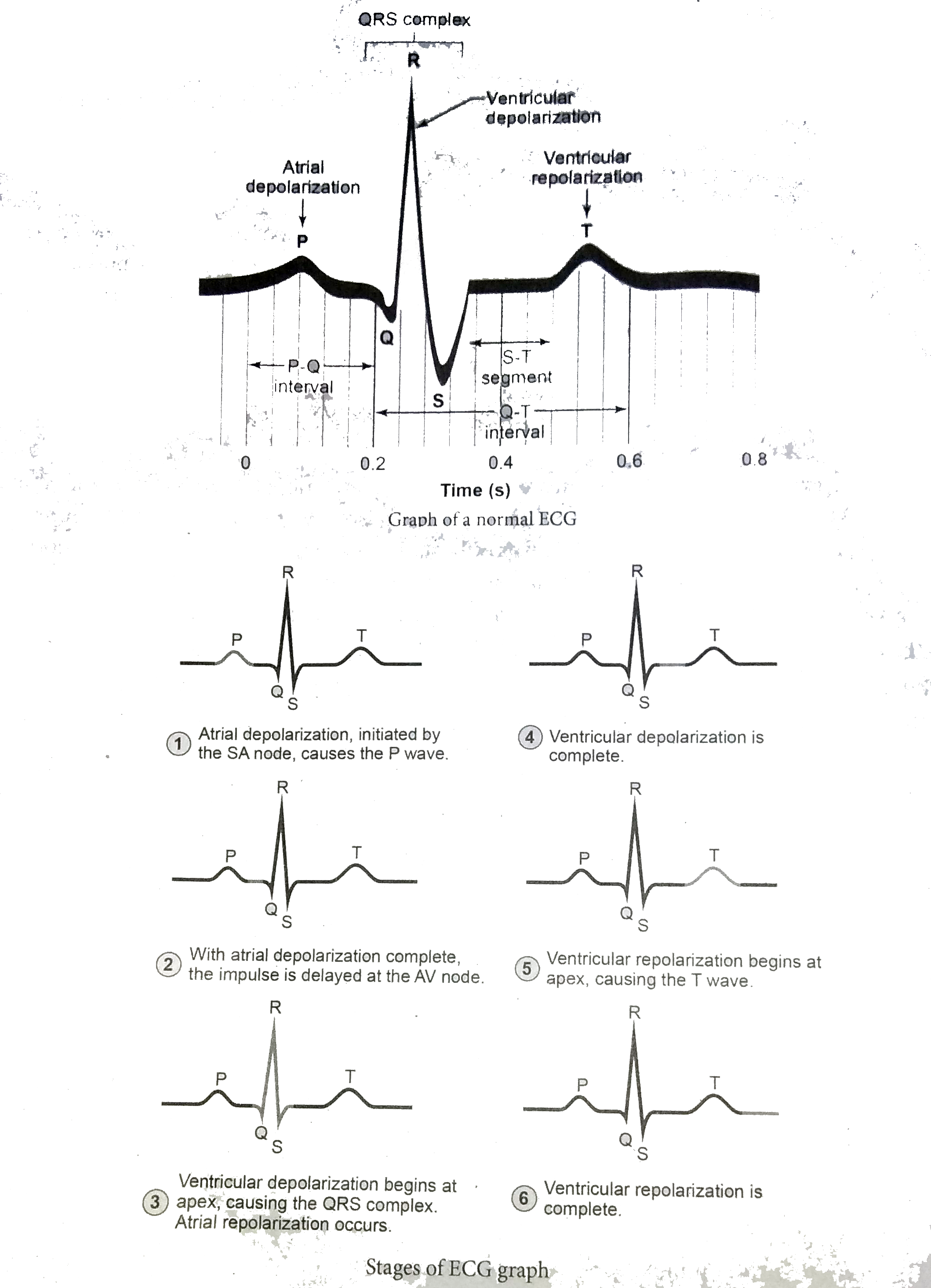Explain the recording of electrocardiogram. Solution in Tamil
An electrocardiogram (ECG) records the electrical activity of the heart over a period of time using electrodes placed on the skin, arms, legs and chest. It records the changes in electrical potential across the heart during one cardiac cycle. The special flap of muscle which initiates the heart beat is called as sinu-auricular node or SA node in the right atrium. It spreads as a wave of contraction in the heart. The waves of the ECG are due to depolarization and not due to contraction of the heart. This wave of depolarisation occurs before the beginning of contraction of the cardiac muscle. A normal ECG shows 3 waves designated as P wave, QRS complex and T wave.
P Wave (atrial depolarisation): It is a small upward wave and indicates the depolarisation of the atria. This is the time taken for the excitation to spread through atria from SA node. Contraction of both atria lasts for around 0.8-1.0 sec.
PQ Interval (AV node delay): It is the onset of P wave to the onset of QRS complex. This is from the start of depolarisation of the atria to the beginning of ventricular depolarisation. It is the time taken for the impulse to travel from the atria to the ventricles (0.12-0.21 sec). It is the measure of AV conduction time.
QRS Complex (ventricular depolarisation): No separate wave for atrial depolarisation in the ECG is visible. Atrial depolarisation occurs simultaneously with the ventricular depolarization. The normal QRS complex lasts for 0.06-0.09 sec. QRS complex is shorter than the P wave, because depolarisation spreads through the Purkinjie fibres. Prolonged QRS wave indicates delayed conduction through the ventricle, often caused due to ventricular hypertrophy or due to a block in the branches of the bundle of His

ST Segment : It lie between the QRS complex and T wave. It is the time during which all regions of the ventricles are completely depolarised and reflects the long plateau phase before repolarisation. In the heart muscle, the prolonged depolarisation is due to retardation of K+ ettlux and is responsible for the plateau. The ST segment lasts for 0.09 sec.
Twave (ventricular depolarisation): It represents ventricular depolarisation. The duration of the T wave is longer than QRS complex because repolarisation takes place simultancousty throughout the ventricular depolarisatiom.
Topper's Solved these Questions
- BODY FLUIDS AND CIRCULATIONBOOK - FULL MARKSCHAPTER - BODY FLUIDS AND CIRCULATIONEXERCISE - ADDITIONAL QUESTIONS SOLVED ( Fill in the Blanks)
76 Videos
- BIOMOLECULESBOOK - FULL MARKSCHAPTER - BIOMOLECULESEXERCISE - ADDITIONAL QUESTIONS SOLVED (Higher Order Thinking Skills)
16 Videos
- CELL CYCLEBOOK - FULL MARKSCHAPTER - CELL CYCLEEXERCISE - ADDITIONAL QUESTIONS SOLVED (Higher Order Thinking Skills)
12 Videos
Similar Questions
The tissue fluid that surrounds the cell is ........
View SolutionIn which form does the glucose is stored in animal cells? Specify the cells?
View SolutionGiven that the average duplication time of E. coli is 20 minutes. How much time will two E. coli cells takes to become 32 cells?
View SolutionWhich of the following correctly explains a phase/event in cardiac cycle in a standard electrocardiogram ?
View SolutionWhich of the following correctly explains a phase/event in cardiac cycle in a standard electrocardiogram
View SolutionElectrocardiogram is a measure of :-
View SolutionWhich of the following correctly explains a phase/event in cardiac cycle in a standard electrocardiogram?
View SolutionWhich of the following correctly explains a phase/event in cardiac cycle in a standard electrocardiogram
View SolutionWhich of the following correctly explains a phase/event in cardiac cycle in a standard electrocardiogram ?
View SolutionWhich of the following correctly explains a phase/event in cardiac cycle in a standard electrocardiogram ?
View SolutionT wave in electrocardiogram represent
View SolutionWhich of the following correctly explains a phase/event in cardiac cycle in a standard electrocardiogram
View SolutionElectrocardiogram
View SolutionECG| Electrocardiogram
View SolutionELECTROCARDIOGRAM
View Solution
